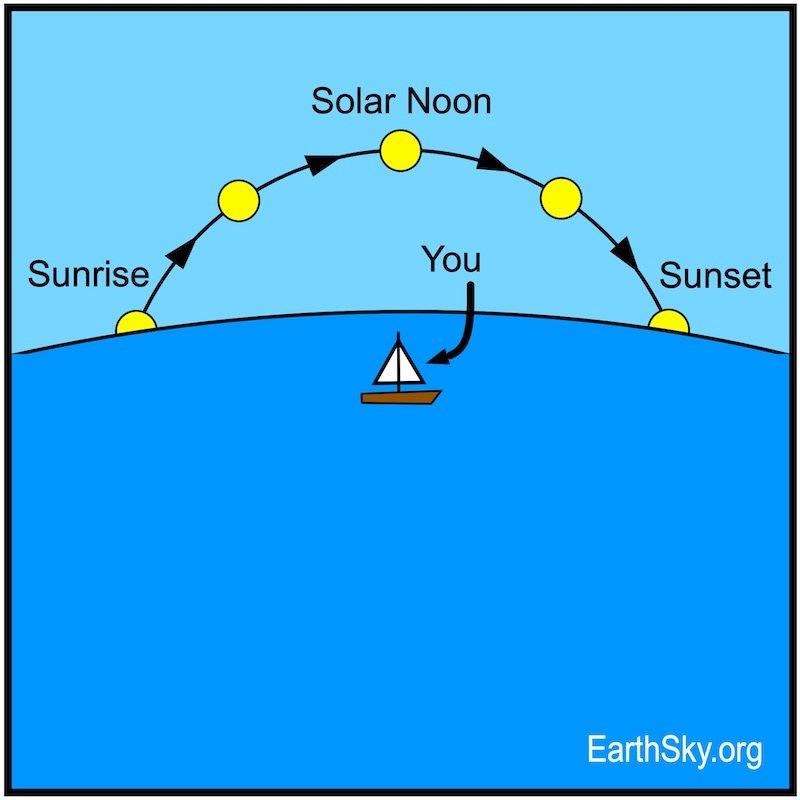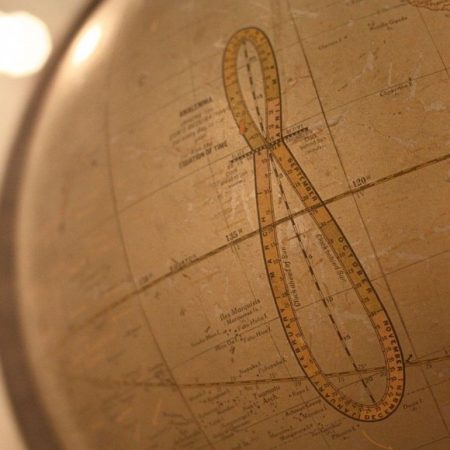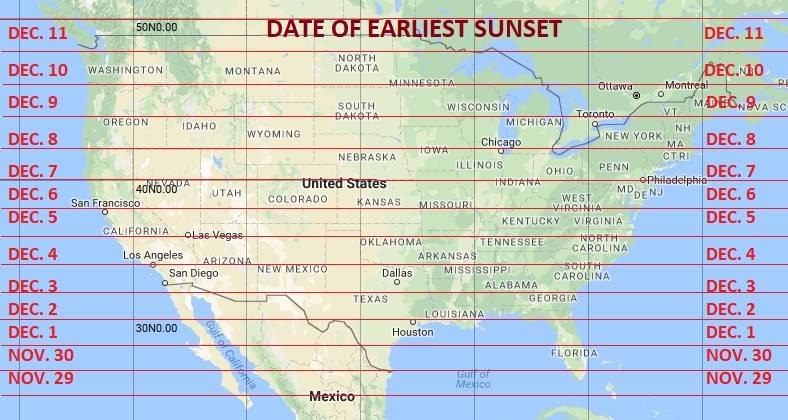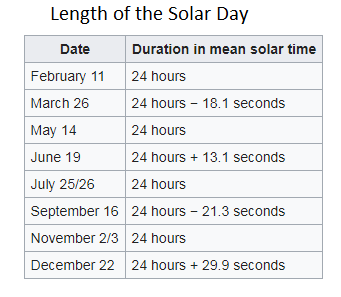
November 3, 2024, ushers in the earliest solar noon – for the whole year and for the entire globe – by the clock. Solar noon is a natural rather than artificial construct, although our clocks and calendars measure its continual shift throughout the year. Solar noon – aka midday – refers to that passing instant when the sun reaches its highest point for the day, midway between sunrise and sunset. If you reside along the center line of your time zone, then solar noon – or midday – comes at 11:43 a.m. by your clock every year in early November. If you’re not on your time zone’s center line – and most of us aren’t – solar noon happens a bit earlier or later by your clock, depending on your offset from your time zone’s center line.
Obscure? Possibly. But the shift in solar noon is tied to a phenomenon that many people around the world might notice in the coming weeks. That is, the earliest solar noon of the year is a prelude to the year’s earliest sunset in the Northern Hemisphere – and the year’s earliest sunrise in the Southern Hemisphere.
You thought the earliest sunset for the Northern Hemisphere came at the December solstice? It doesn’t. It happens well before that solstice, for a reason that’s related to the earliest solar noon on November 3.


Earliest and latest solar noons, and the length of the day. The first several days of November, from everywhere worldwide, the days (as measured from one solar noon to the next) are almost exactly 24 hours in duration. Thereafter, day by day, solar noon comes later and later by the clock, lessening the discrepancy between sun time and clock time. At long last – on December 25, 2024 – the sun and the clock agree with one another, with solar noon coming at 12 noon by the clock (for those at the center line of a given time zone).
Although the sun and clock will agree on December 25, 2024, the duration of the solar day – as measured from one solar noon to the next – will continue to exceed 24 hours each day for another six weeks.
Finally, the latest solar noon will arrive on or near February 11, at 12:14 p.m. by the clock (at the time zone center line).
And, for everyone, everywhere worldwide, solar noon comes some 30 minutes earlier by the clock on November 3, 2024, than it will on February 11, 2025.
Want to know the clock time for solar noon (midday) at your location? Visit Sunrise Sunset Calendars, remembering to check the solar noon box.
Want to know the time difference between sun and clock for any date? Go to AstroPixels.com and look under the equation of time column.

Solar noon and earliest sunset (and/or sunrise). So … November 3, 2024, marks the earliest solar noon of the year for the whole globe. What’s more, residents at the Earth’s equator have their earliest sunrise and sunset on November 3. That’s because, at the equator, the daylight hours remain virtually the same throughout the year – so the earliest sunrise, earliest solar noon and earliest sunset all fall on the same day.
Elsewhere – within the tropical and temperate regions of the world – the shortest period of daylight happens on the day of the winter solstice, and the longest period of daylight on the summer solstice. So if you live near the Arctic Circle, your earliest sunset doesn’t happen until around the December (winter) solstice; or if you live near the Antarctic Circle, your earliest sunrise doesn’t take place until around the December (summer) solstice.
That’s in spite of the earliest solar noon coming in early November all over the world.
Read more: December solstice starts shortest season

If you live north of the equator but south of the Arctic Circle, your earliest sunset occurs somewhere between November 3, 2024, and December 21, 2024. In the Northern Hemisphere, those living closer to the equator have an earlier date for their earliest sunset; and those lodging closer to the Arctic Circle have a later date for their earliest sunset.
We give the approximate dates for the earliest sunset in the Northern Hemisphere:
15 degrees north latitude
Earliest sunset on or near November 2330 degrees north latitude
Earliest sunset on or near December 145 degrees north latitude
Earliest sunset on or near December 1060 degrees north latitude
Earliest sunset on or near December 17
In the Southern Hemisphere, it’s your earliest sunrise that takes place between November 3, 2024, and December 21, 2024. The closer you live to the equator, the earlier the date for the earliest sunrise; and the closer you live to the Antarctic Circle, the later the date for the earliest sunrise. Because comparable latitudes north/south of the equator have the same approximate dates for earliest sunset/earliest sunrise, the dates for the Southern Hemisphere’s earliest sunrises can be gleaned from the listing above.
In the Northern Hemisphere, the latest sunrise must wait till after the Northern Hemisphere’s December winter solstice; and in the Southern Hemisphere, it’s the latest sunset that must wait till after the Southern Hemisphere’s December summer solstice. Those living closer to the Arctic or Antarctic Circles have an earlier date for their latest sunrise/latest sunset; and those lodging closer to the Earth’s equator have a later date for their latest sunrise/latest sunset. Here are the approximate dates for the Northern Hemisphere’s latest sunrise/Southern Hemisphere’s latest sunset at various latitudes:
60 degrees latitude: December 27
45 degrees latitude: January 2
30 degrees latitude: January 11
15 degrees latitude: January 23
Two reasons account for the unequal length of the solar day over the year. First and foremost, the tilt of the Earth’s axis causes the solar day to be more than 24 hours long around the solstices yet less than 24 hours long around the equinoxes. However, Earth’s eccentric orbit plays a secondary role, either accentuating or lessening the effect. At the December solstice, the Earth is some 3 million miles (5 million km) closer to the sun, and moving more swiftly in its orbit, than on the June solstice. Therefore, the longer-than-average solar day at the December solstice (24 hours + 30 seconds) outlasts the longer-than-average solar day at the June solstice (24 hours + 13 seconds).

Bottom line: November 3 brings the year’s earliest solar noon – that is, earliest midday – by nature’s clock. It’s a harbinger of the Northern Hemisphere’s earliest sunset.











